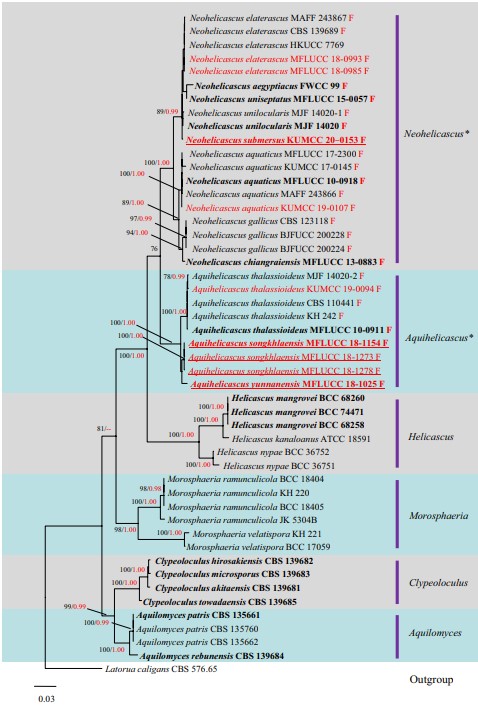Neohelicascus aquaticus (H. Zhang & K. D. Hyde) W. Dong, K.D. Hyde & H. Zhang, comb. nov.
MycoBank number: MB 557922; Index Fungorum number: IF 557922; Facesoffungi number: FoF09264; Fig. 81
Basionym: Helicascus aquaticus H. Zhang & K.D. Hyde, Sydowia 65(1): 155 (2013)
Synonymy: Helicascus alatus M. Zeng, S.K. Huang, Q. Zhao & K.D. Hyde, Phytotaxa 351(3): 215 (2018)
Freshwater distribution: China (Zeng et al. 2018; this study), Japan (Tanaka et al. 2015), Thailand (Zhang et al. 2013a)
Saprobic on decaying wood submerged in freshwater. Sexual morph: Pseudostromata clustered, immersed, ampulliform, coriaceous, with ostiolate papilla, visible on the host surface as blackened ostiolar dots. Pseudoparaphyses 1–3 μm diam., abundant, cellular, hypha-like, hyaline, septate, embedded in a gelatinous matrix. Asci 90–120 × 14–21 μm (x̄ = 110 × 19 μm, n = 5), 8-spored, bitunicate, fissitunicate, clavate, pedicellate. Ascospores 20–23 × 8–10 μm (x̄ = 22 × 8.5 μm, n = 15), mostly biseriate, ellipsoidal, brown, 1-septate, slightly constricted at septum, asymmetrical, apical cell usually longer than basal cell, curved, thin-walled, smooth, with a deliquescing sheath. Asexual morph: Undetermined.
Culture characteristics: On PDA, colony circular, reaching 40 mm in 50 days at 25 °C, reddish brown to black from above, reddish brown from below, surface rough, dry, umbonate, edge entire.
Material examined: CHINA, Yunnan Province, Qujing, on submerged wood in a stream, 10 May 2017, C.X. Liu, L25 (HKAS 102145), living culture KUMCC 19-0107.
Notes: The LSU and ITS sequence data from our collection HKAS 102145 shows 100% identity with the sequences of Helicascus aquaticus (MFLUCC 10-0918). HKAS 102145 fits well with the morphological features of H. aquaticus (Zhang et al. 2013a). However, we did not observe the 3-septate ascospores and asexual morph in culture.
Helicascus alatus was introduced by Zeng et al. (2018) based on multigene phylogenetic analysis and morphological characters. Zeng et al. (2018) considered that H. alatus differs from H. aquaticus in smaller ascomata, short pedicels and presence of a sheath. However, a comparion of nucleotides shows that H. alatus (MFLUCC 17-2300) and H. aquaticus (MFLUCC 10-0918) have identical sequences in LSU and ITS sequence data. Additionally, there are only two nucleotide differences in TEF sequence data between H. alatus (MFLUCC 17-2300) and H. aquaticus (MAFF 243866), thus H. alatus is a synonymy of H. aquaticus. Phylogenetic analysis supports these strains to be the same species (Fig. 84).

Fig. 81 Neohelicascus aquaticus (HKAS 102145). a, b Immersed pseudostromata with blackened ostiolar dots. c Pseudoparaphyses. d Bitunicate ascus. e, f Ascospores. g, h Colony on PDA (up-front, down-reverse). Scale bars: c, f = 10 μm, d = 30 μm, e = 20 μm

Fig. 84 Phylogram generated from maximum likelihood analysis of combined LSU, SSU, ITS and TEF sequence data for species of Morosphaeriaceae. Bootstrap values for maximum likelihood equal to or greater than 75% and Bayesian posterior probabilities equal to or greater than 0.95 are placed near the branches as ML/BYPP. Newly generated sequences are in red and ex-type strains are in bold. The new species introduced in this study are indicated with underline. Freshwater strains are indicated with a red letter “F”. The tree is rooted to Latorua caligans CBS 576.65 (Latoruaceae)
